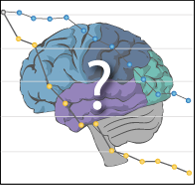Archive for the ‘Professional Issues’ Category
Monday, June 20th, 2011
 Today the web-based newspaper The Daily published a front-page article on Infra-Low Frequency Neurofeedback in application to PTSD. Along with the article there is also a six-minute video that illustrates the training procedure and basic approach. Reporter Katie Drummond did her homework on this topic over a number of months, finally coming out to our office from New York and showing up at our office with a video crew in order to try the training herself and to get acquainted with the principals. Today the web-based newspaper The Daily published a front-page article on Infra-Low Frequency Neurofeedback in application to PTSD. Along with the article there is also a six-minute video that illustrates the training procedure and basic approach. Reporter Katie Drummond did her homework on this topic over a number of months, finally coming out to our office from New York and showing up at our office with a video crew in order to try the training herself and to get acquainted with the principals.
(more…)
Posted in Application of Neurofeedback, Biofeedback, Commentary, Neurofeedback, Professional Issues, PTSD, Veterans, Video | No Comments »
Wednesday, January 6th, 2010
 To someone who has been educated in the sciences it is somewhat jarring to see so many people blithely dismiss the alarming evidence in favor of global warming. And yet when it comes to neurofeedback, we are quite comfortable flying in the face of mainstream thinking and simply dismissing the mainstream position (of skepticism with respect to neurofeedback) as essentially meaningless. In one case, we regard scientific consensus as highly significant; in the other, we hold it in utter contempt. How can one justify both positions simultaneously? To someone who has been educated in the sciences it is somewhat jarring to see so many people blithely dismiss the alarming evidence in favor of global warming. And yet when it comes to neurofeedback, we are quite comfortable flying in the face of mainstream thinking and simply dismissing the mainstream position (of skepticism with respect to neurofeedback) as essentially meaningless. In one case, we regard scientific consensus as highly significant; in the other, we hold it in utter contempt. How can one justify both positions simultaneously?
The answer lies in the nature of the evidence for both propositions. What makes the case in favor of global warming so persuasive is that it is supported by so many independent lines of evidence, all of which collectively support a model that in turn is also well-supported, namely the key influence of atmospheric CO2 concentrations on global temperatures. Much of this evidence came to exist in the course of research that was unrelated to the issue of global warming. Add to the known influence of CO2 that of many other gaseous effluents, which can be tens to thousands of times worse in terms of their greenhouse effect, and we have ourselves a rather dangerous stew.
For evidence, one needs to look at those changes that average over short-term fluctuations, and one needs to look at regions where the effects are expected to be largest and to show up first: the arctic. Already we know that arctic summer sea ice is running at less than half of what it was half a century ago. Ominous signs of the decay of ice sheets are also seen in the Antarctic. Supporting evidence is then furnished by such findings as arctic flowers blooming earlier, butterflies moving their territories northward in England, and birds advancing the calendar on their nesting behavior. Altered composition of phytoplankton in arctic waters indicates that chemical changes have reached the level of biological significance.
(more…)
Posted in Commentary, Neurofeedback, Professional Issues, Research, Scientific | 2 Comments »
Monday, November 23rd, 2009
 Up to this point, commentary on Major Hasan has had as much to do with us, the observers, as with Hasan himself, given how little we actually know about him. One wants to be careful not to jump to conclusions prematurely. That may also have been at work early on while Major Hasan was working at the Walter Reed Army Medical Center. The question has been raised as to why his colleagues at Walter Reed did not pick up on the various signs of instability and of mental disturbance in Major Hasan during his years there. Up to this point, commentary on Major Hasan has had as much to do with us, the observers, as with Hasan himself, given how little we actually know about him. One wants to be careful not to jump to conclusions prematurely. That may also have been at work early on while Major Hasan was working at the Walter Reed Army Medical Center. The question has been raised as to why his colleagues at Walter Reed did not pick up on the various signs of instability and of mental disturbance in Major Hasan during his years there.
The professional reluctance to identify Hasan as a problem may very well have been due to the “protective garb” provided him by his status as a psychiatrist. He was one of them. Beyond the simple reluctance to indict a professional colleague, there is also the assumption that such an individual has more resources to “pull himself together” and to conduct his life within acceptable bounds even if he has “issues.” The mental health disciplines have developed from a very rational framework that unsurprisingly places the rational order at the top of our regulatory hierarchy. In the disciplined mind, rationality rules the emotions. The will is unquestionably in charge of our actions.
(more…)
Posted in Application of Neurofeedback, Neurofeedback, Professional Issues, PTSD, Veterans | 4 Comments »
Monday, January 26th, 2009
 The inauguration of President Barack Obama was another one of those rare events that draws our individual nervous systems into collective patterns of activity all the way across the nation. David Kaiser did his dissertation on this general topic, monitoring a number of EEGs while a movie was being watched to determine the degree to which common and reproducible EEG activity was evoked as emotionally gripping scenes were on-screen. Ever since, I have on occasions like this imagined EEGs moving in a kind of unison across the country as we all watch the same emotionally evocative event at the same time. The inauguration of President Barack Obama was another one of those rare events that draws our individual nervous systems into collective patterns of activity all the way across the nation. David Kaiser did his dissertation on this general topic, monitoring a number of EEGs while a movie was being watched to determine the degree to which common and reproducible EEG activity was evoked as emotionally gripping scenes were on-screen. Ever since, I have on occasions like this imagined EEGs moving in a kind of unison across the country as we all watch the same emotionally evocative event at the same time.
A bias intrudes here however, in that good feelings tend not to be transitory or episodic, but rather to persist over time. So they are less likely to be noticeable in the EEG as sudden shifts than when we are dealing with negative or aversive events. Thus, our concern when Chief Justice Roberts flubbed his lines probably registered more strongly in our EEGs than the more persistent good feeling about the transition of power that was symbolized in the giving of the oath.
Then came the sober inaugural address, in which the dire circumstances in which the nation finds itself needed to be couched in palatable terms. How does one maintain optimism at a time like this? No one did this better than Franklin Roosevelt in his day, and no one does it better than Barack Obama now. Neither, however, had a substantive basis for optimistic projections beyond the notion that America usually finds its way out of the muddles it makes. This is not merely our self-delusion. Outsiders have the same impression. Said Bismarck: “God looks after drunks, little children, and the United States of America.” Or Churchill: “America usually solves its problems, after trying everything else first.” (more…)
Posted in Application of Neurofeedback, Commentary, Neurofeedback, Professional Issues | 1 Comment »
Thursday, May 29th, 2008
 Some years ago, the Economist Magazine covered the nascent neurotechnologies and came up somewhat alarmed about our potential futures. If people were concerned about such issues as genetically modified foods, stem cell research, genetic screening, etc., they should really be worried about what the future has in store with regard to the alteration of brain function. That future looked really scary for its loosening of the moorings on who we are and who might have the power to shape our individual futures. Some years ago, the Economist Magazine covered the nascent neurotechnologies and came up somewhat alarmed about our potential futures. If people were concerned about such issues as genetically modified foods, stem cell research, genetic screening, etc., they should really be worried about what the future has in store with regard to the alteration of brain function. That future looked really scary for its loosening of the moorings on who we are and who might have the power to shape our individual futures.
Now it is several years later, and the Economist sounds a very different tone in discussing the potential of brain-altering drugs that may enhance memory, concentration, and learning. Our future with “cognition enhancers” seems almost entirely positive. We are having our first relevant experience even now as existing drugs are being used “off-label” by populations that carry no diagnosis. “Provigil and Ritalin really do enhance cognition in healthy people,” urges the Economist. Provigil can add about a digit to one’s digit span and both Provigil and Ritalin can enhance executive function. (more…)
Posted in Commentary, Neurofeedback, Professional Issues | 4 Comments »
Thursday, May 29th, 2008
 The unlicensed practice of neurofeedback has arisen again as an issue with an article written by Cory Hammond that appeared in a recent issue of the National Psychologist newspaper. Following a concise and favorable introduction to neurofeedback, Cory Hammond wrote the following: The unlicensed practice of neurofeedback has arisen again as an issue with an article written by Cory Hammond that appeared in a recent issue of the National Psychologist newspaper. Following a concise and favorable introduction to neurofeedback, Cory Hammond wrote the following:
“It is crucial for licensed professionals
to report lay neurofeedback practitioners to
state regulatory bodies as practicing psychology
and medicine without a license when they are
found to be offering services for medical,
psychiatric and psychological conditions.”
One might on a first reading gain the impression that lay practitioners meant such people as enthusiastic home users who at some point decided to hang out a shingle, but when Dr. Hammond was asked whether he was including such unlicensed people as Professor Barry Sterman, the original researcher of the field, he replied:
“If he is offering clinical services to the public for medical,
psychiatric and psychological problems, without holding a clinical
license, he would be in violation of the law in almost every state.”
(more…)
Posted in Commentary, Neurofeedback, Professional Issues | 13 Comments »
|
|
Subscribe to Email Newsletter
The EEG Info Newsletter circulates via email at least once a month. A variety of topics related to the Neurofeedback / EEG Biofeedback field are covered in over 200 articles.
|
 To someone who has been educated in the sciences it is somewhat jarring to see so many people blithely dismiss the alarming evidence in favor of global warming. And yet when it comes to neurofeedback, we are quite comfortable flying in the face of mainstream thinking and simply dismissing the mainstream position (of skepticism with respect to neurofeedback) as essentially meaningless. In one case, we regard scientific consensus as highly significant; in the other, we hold it in utter contempt. How can one justify both positions simultaneously?
To someone who has been educated in the sciences it is somewhat jarring to see so many people blithely dismiss the alarming evidence in favor of global warming. And yet when it comes to neurofeedback, we are quite comfortable flying in the face of mainstream thinking and simply dismissing the mainstream position (of skepticism with respect to neurofeedback) as essentially meaningless. In one case, we regard scientific consensus as highly significant; in the other, we hold it in utter contempt. How can one justify both positions simultaneously?
 Up to this point, commentary on Major Hasan has had as much to do with us, the observers, as with Hasan himself, given how little we actually know about him. One wants to be careful not to jump to conclusions prematurely. That may also have been at work early on while Major Hasan was working at the Walter Reed Army Medical Center. The question has been raised as to why his colleagues at Walter Reed did not pick up on the various signs of instability and of mental disturbance in Major Hasan during his years there.
Up to this point, commentary on Major Hasan has had as much to do with us, the observers, as with Hasan himself, given how little we actually know about him. One wants to be careful not to jump to conclusions prematurely. That may also have been at work early on while Major Hasan was working at the Walter Reed Army Medical Center. The question has been raised as to why his colleagues at Walter Reed did not pick up on the various signs of instability and of mental disturbance in Major Hasan during his years there. The inauguration of President Barack Obama was another one of those rare events that draws our individual nervous systems into collective patterns of activity all the way across the nation. David Kaiser did his dissertation on this general topic, monitoring a number of EEGs while a movie was being watched to determine the degree to which common and reproducible EEG activity was evoked as emotionally gripping scenes were on-screen. Ever since, I have on occasions like this imagined EEGs moving in a kind of unison across the country as we all watch the same emotionally evocative event at the same time.
The inauguration of President Barack Obama was another one of those rare events that draws our individual nervous systems into collective patterns of activity all the way across the nation. David Kaiser did his dissertation on this general topic, monitoring a number of EEGs while a movie was being watched to determine the degree to which common and reproducible EEG activity was evoked as emotionally gripping scenes were on-screen. Ever since, I have on occasions like this imagined EEGs moving in a kind of unison across the country as we all watch the same emotionally evocative event at the same time. Some years ago, the Economist Magazine covered the nascent neurotechnologies and came up somewhat alarmed about our potential futures. If people were concerned about such issues as genetically modified foods, stem cell research, genetic screening, etc., they should really be worried about what the future has in store with regard to the alteration of brain function. That future looked really scary for its loosening of the moorings on who we are and who might have the power to shape our individual futures.
Some years ago, the Economist Magazine covered the nascent neurotechnologies and came up somewhat alarmed about our potential futures. If people were concerned about such issues as genetically modified foods, stem cell research, genetic screening, etc., they should really be worried about what the future has in store with regard to the alteration of brain function. That future looked really scary for its loosening of the moorings on who we are and who might have the power to shape our individual futures. The unlicensed practice of neurofeedback has arisen again as an issue with an article written by Cory Hammond that appeared in a recent issue of the
The unlicensed practice of neurofeedback has arisen again as an issue with an article written by Cory Hammond that appeared in a recent issue of the
Breaking News on PTSD & Neurofeedback
Monday, June 20th, 2011(more…)
Posted in Application of Neurofeedback, Biofeedback, Commentary, Neurofeedback, Professional Issues, PTSD, Veterans, Video | No Comments »